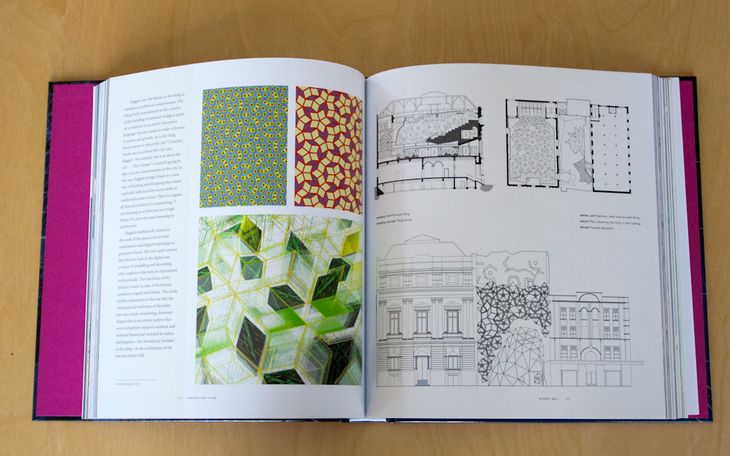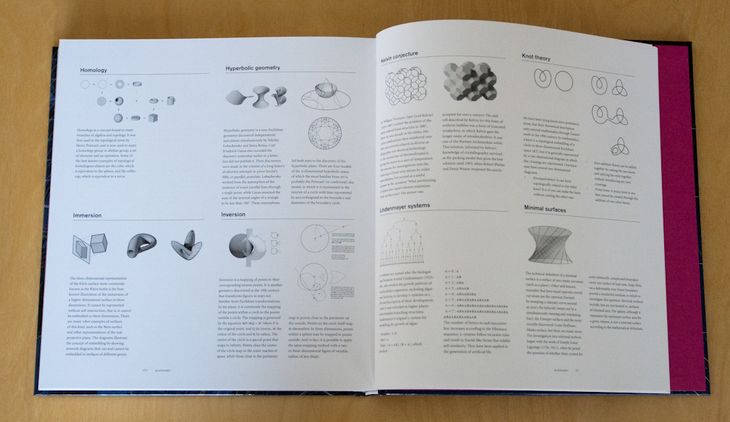This is not going to be the most objective review of Jane Burry and Mark Burry's latest book, The New Mathematics of Architecture (Amazon), because I produced over 50 of the book's illustrations, but hopefully this also allows me to offer some insight into the production.

Story Hall in Melbourne - Aperiodic tiling
The book itself has been under production for almost seven years. It was conceived during the 2003 'Non-standard Architectures Exhibition' at the Pompidou Center where Mark Burry exhibited, and gestated while many of the projects inside the book were built. The key realisation at the time, and the key relisation of the book, is that: computation is allowing architects to engage in mathematics without numbers. This revolution was only just starting in 2003, and now in 2010 there has been enough projects built that the thesis is no longer speculative or theoretical. Jane and Mark make this argument in the introduction of the book and then explore how this new mathematics is manifested in 46, mostly built, projects. The mathematics described is not your high school algebra and calculus - very few formula and no trig functions - instead this new mathematics draws largely on post-17th century maths, with concepts such as: Aperiodic tiling, chaos theory, developable surfaces, inversion, minimal surfaces and non-euclidean geometry. The book then concludes with a glossary that describes each of these concepts in detail.

Biothing (biothing.org)
As to whether this is a good book, in my very non-objective opinion, The New Mathematics of Architecture articulates a major change in the use of mathematics. It is the type of book I would have enjoyed as a student, big pictures you can browse through for inspiration, but a lot of substance in the text. In a way I did have this book as I was doing my final year, I discovered Pareto optimisation while doing an illustration of it for the book, and ended up basing my entire final year project around it, so perhaps the book is already working as a source of inspiration. But you will have to make up your own mind as to its merits (get it at Amazon). If you have a review or know of any, post a comment and I will link to it below.

Glossary

Lloyd Stagg
Having only read the first chapter, Mathematical Surfaces and Seriality and flipped throught the rest I am already of the opinion that to some extent the book is incompletely titled. As you say the book is more about the impact on architecture of computational capabilities than conventional mathematics such as algebra, calculus and triginometry. Nevertheless the images are quite stricking and thought provoking. Inversion, mentioned in chaptr one, is a concept I intend to follow up on. Other concepts you mention such as Pareto optimisation and aperiodic tiling also intrigue and will draw me back into this compendium.
Daniel
Hi Lloyd,
I am not sure if it is mentioned in the book, but the words "New Mathematics" is partly a reference to the 1960's new math movement: http://en.wikipedia.org/wiki/New_Math
I agree the maths in the book is unexpected, I think this is because in school we are taught about mathematics up until 17th century (the discovery of calculus) and never really what happened after that. I always thought a mathematician worked on really hard algebra problems, but it has been exciting to discover most of them are making weird and new spacial organisations, which with the aid of computation can be appropriated by architects.
Look forward to hearing what you think of the rest of the book, and whether you manage to sneak some Inversion into one of your projects,
Daniel
Eric
Hi Daniel,
I think your blog is very intriguing and I would like to join the discussion regarding Parametricism as a style. I came across this book (link below) about architectural geometry over the summer and am reading it now. It provides good insight into modeling but lacks the mathematical aspects that I was hoping for. I am looking for a book that is bare bones mathematics. Essentially, I would like to find a book that describes the architectural process using parametric/mathematical equations as a tool in design; illustrating how to calculate the locations of points, curves and the formation of surfaces. Because like you said in your post computers take away the mathematical aspects for architects but I will definitely be ordering this book in the next few weeks in hopes that I will find what I am looking for. Thanks for the great blog.
http://www.bentley.com/en-US/Training/Products/Resources/Books/Architectural+Geometry.htm
Kiros
Ehy Eric I wanted to find the same u said, and I wanted to ask you if u found what u wanted in that book http://www.bentley.com/en-US/Training/Products/Resources/Books/Architectural+Geometry.htm
If yes I'm going to buy it too, what do u think about? is what we wanna find?thanks alot Kiros
Eric
Hi Kiros,
I think with that Architectural Geometry book and Kostas Terzidis' Algorithmic Architecture you can find everything you need to begin building parametric forms in 3D Space. I hope this helps. Feel free to contact me via Facebook if you have any questions. http://www.facebook.com/pages/Epiphysis-Studio/268213136529212?sk=info
-Eric
Daniel
Hi Eric,
I often refer to the Architectural Geometry book. I find it useful for getting a clear, albeit rough, idea of some of the core mathematical principles of modelling but I find I still use Wikipedia as my main source.
I have not come across a book that lays out the bare bones of mathematical geometry, although I would love to find one. I suspect the reason it has not been written is that the topic is too broad and that architects have such a varied knowledge of mathematics. Probably the closest thing is some of the books on computer programming for game design, where they will often go through the maths of surfaces, and vectors ect. William Mitchell also wrote a book a while ago called "The Art of Computer Graphics Programming: A Structured Introduction for Architects and Designers" which goes through some of the basic formula - hard to find a copy of though.
Daniel
Leslie
Hi Eric I'm an Interior Design major at the Art Institute and I'm doing my final thesis about Parametricism. Since it is a fairly new term there isn't many sources I can find info about it, except in all of Patrik Schumacher's writings and Zaha Hadid's built work. I really need some help, pointers and input about this term and it's application. I'd really it if you can reply back and give me some thoughts on how to mold my research. Hope to hear from you soon Leslie C.
Eric
Hi Leslie,
I have found a couple books that provide tutorials that lend to the type of work that would involve parametircism. First, Kostas Terzidis’ (http://www.amazon.com/Algorithmic-Architecture-Kostas-Terzidis/dp/0750667257) Algorithmic Architecture provides a good chapter on how to use Maya and the MEL scripting language for form finding. The algorithms he provides are simple but it is a good starting point. Essentially, variables and methods drive the form and as you change them the form changes. If you do not know how to use Maya, I recommend using Max. There is a plug-in with tutorials for Max at http://www.torabiarchitect.com/blog/?page_id=190. Ali Torabi actually goes through the implementation of his plug-in and it is a neat plug-in. I have used both Max and Maya and these are by far my favorite parametric tools. By going over these, you should begin to get an idea of what parametric design is. In addition, there is a book that provides additional algorithms titled Pamphlet Architecture 27: Tooling (http://www.amazon.com/Pamphlet-Architecture-27-Benjamin-Aranda/dp/1568985479). Furthermore, Revit is a good tool as well, though; I think its parametric capabilities are limited. It was the first tool I used for parametric design and I have not used it for about a year. I did find that if you use the nested panels in Revit and export FBX file, you could use Max to create some nice renderings. Lastly, to do anything parametric you should learn to script. I think you could get by with the basics and Processing (http://processing.org/) is a good starting point for the basics. Casey and Ben have done an exceptional job at creating a fast sketching tool is easily adaptable for beginner programmers. There is a lot here and I know it probably reads somewhat sporadic. If you have, any questions feel free to contact me via facebook. http://www.facebook.com/pages/Epiphysis-Studio/268213136529212?sk=info. There is just a lot that goes into fully understanding parametric design. I hope this helps and that your research goes well.
-Eric
Daniel
Hi Eric and Leslie,
That is a fantastic list of resources Eric, thanks for sharing it. I would add Grasshopper by McNeel to that list as well.
Regarding writing on 'Parametricism,' your first decision should be whether you agree with the term. I have written about why I don't agree with it here: http://www.nzarchitecture.com/blog/index.php/2010/09/25/patrik-schumacher-parametricism/
And Mark Burry in Scripting Cultures has given reasons for why it may be an inappropriate term: http://www.nzarchitecture.com/blog/index.php/2011/11/05/scripting-cultures-mark-burry/
Of course there are those in favor as well. Once you find your own position, the writing will be much easier.
Daniel
Leslie
Thank you guys so much for your help id like to know why you feel parametric design helps architecture vs modernism. What about its fluidity helps our environment, our organizational function in architecture. Thanks again Leslie C.